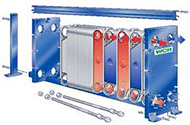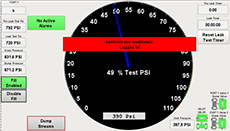Heat Exchanger Pneumatic Pressure Tester
 Customer: Heat Exchanger Manufacturer
Customer: Heat Exchanger Manufacturer
Project Scope: Part of the manufacturing process for heat exchangers is to test the core under high pneumatic static pressure. The old process was performed manually, provided rough test documentation, and had the potential to over pressure the core to the point that it would need to be scrapped. Any over pressurization beyond specification would need to be reported to the customer and, at times, the customer would not accept the core or it would need to be down-graded. Frequently, multiple cores streams would need to be tested at the same time, called a Simultaneous test, which required multiple chart recorders.
 Project Design: Industrial Automation was asked to design, construct, and program a heat exchanger pneumatic pressure tester. The new pressure tester utilizes an Allen Bradley Compact Logix PAC controller to monitor all system pressure and limit sensors and control all pressure testing and plant air valves. A 21 inch industrial touchscreen connected to a PC running Ignition from Inductive Automation serves as the HMI/ SCADA system. The ignition SCADA/HMI system controls, monitors, and records regulated core stream pressures along with supply side high pressure values. Since the Ignition system is not dependent on any specific operating system, there’s no concerns about operating system dependency.
Project Design: Industrial Automation was asked to design, construct, and program a heat exchanger pneumatic pressure tester. The new pressure tester utilizes an Allen Bradley Compact Logix PAC controller to monitor all system pressure and limit sensors and control all pressure testing and plant air valves. A 21 inch industrial touchscreen connected to a PC running Ignition from Inductive Automation serves as the HMI/ SCADA system. The ignition SCADA/HMI system controls, monitors, and records regulated core stream pressures along with supply side high pressure values. Since the Ignition system is not dependent on any specific operating system, there’s no concerns about operating system dependency.


The tester design included valves and pressure sensors to monitor and control the inlet test gas pressure to two isolated single stream zones, simultaneously. Three qualified persons are each required to enter the core test parameters (via the touch screen) prior to starting each test. Each person is assigned a specific key to gain access to the corresponding test setup screen. When all three sets of data match, the appropriate valves are energized to allow the pressure test to start. In addition to the test setup security, there is also a maintenance setup and calibration page that requires a key and password to enter.
 As the core is being manually pressurized by an operator, the control monitors the core pressure. If the core pressure is greater than or equal to the test pressure and less than the dump settings, the core is ready for the operator to start the pneumatic test. If the core pressure reaches the “Inlet close” pressure settings, the control will close the supply gas valve. If the core pressure reaches the “dump” pressure settings, the control will open the discharge valves from the appropriate core stream to relieve the core pressure. If the core loses too much pressure during a predetermined time, the test is aborted. If the test is passed, then all of the test data is gathered into a printable report. In addition, the data is saved to a database for future use.
As the core is being manually pressurized by an operator, the control monitors the core pressure. If the core pressure is greater than or equal to the test pressure and less than the dump settings, the core is ready for the operator to start the pneumatic test. If the core pressure reaches the “Inlet close” pressure settings, the control will close the supply gas valve. If the core pressure reaches the “dump” pressure settings, the control will open the discharge valves from the appropriate core stream to relieve the core pressure. If the core loses too much pressure during a predetermined time, the test is aborted. If the test is passed, then all of the test data is gathered into a printable report. In addition, the data is saved to a database for future use.
Project Results: The heat exchanger pneumatic pressure tester delivers the machine safety, simplicity, reliability, speed, and a test data report as promised. The management team is pleased with the installation and the ability to update and change the project on the fly.
